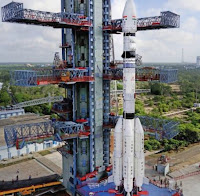GSAT-6 is the twenty fifth geostationary communication satellite of India built by ISRO and twelfth in the GSAT series. Five of GSAT-6's predecessors were launched by GSLV during 2001, 2003, 2004, 2007 and 2014 respectively. After its commissioning, GSAT-6 joined the group of India's other operational geostationary satellites.
GSAT-6 Satellite provides communication through S-band payload with five spot beams covering whole India for user links and C-band with one beam. The cuboid shaped GSAT-6 has a lift-off mass of 2117 kg. Of this, propellants weigh 1132 kg and the dry mass of the satellite is 985 kg. One of the advanced features of GSAT-6 satellite is its S-Band Unfurlable Antenna of 6 m diameter. This is the largest satellite antenna realised by ISRO. This antenna is utilised for five spot beams over the Indian main land. The spot beams exploit the frequency reuse scheme to increase frequency spectrum utilization efficiency. The other advanced feature of the satellite is the 70 V bus, which is flying first time in an Indian communication satellite
Soon after its injection into GTO, the two solar arrays of GSAT-6 were automatically deployed and the Master Control Facility (MCF) at Hassan in Karnataka took control of GSAT-6. Subsequently, GSAT-6's orbit was raised to the final circular Geostationary Orbit (GSO) by firing the satellite's Liquid Apogee Motor (LAM) in stages. The satellite was declared operational after the completion of orbit raising operations, deployment of its 6 m wide sieve shaped unflappable antenna, the satellite’s positioning in its designated orbital slot of 83 degree East longitude in the GSO and in-orbit testing of its communication payloads.
GSAT-6 Satellite provides communication through S-band payload with five spot beams covering whole India for user links and C-band with one beam. The cuboid shaped GSAT-6 has a lift-off mass of 2117 kg. Of this, propellants weigh 1132 kg and the dry mass of the satellite is 985 kg. One of the advanced features of GSAT-6 satellite is its S-Band Unfurlable Antenna of 6 m diameter. This is the largest satellite antenna realised by ISRO. This antenna is utilised for five spot beams over the Indian main land. The spot beams exploit the frequency reuse scheme to increase frequency spectrum utilization efficiency. The other advanced feature of the satellite is the 70 V bus, which is flying first time in an Indian communication satellite
Soon after its injection into GTO, the two solar arrays of GSAT-6 were automatically deployed and the Master Control Facility (MCF) at Hassan in Karnataka took control of GSAT-6. Subsequently, GSAT-6's orbit was raised to the final circular Geostationary Orbit (GSO) by firing the satellite's Liquid Apogee Motor (LAM) in stages. The satellite was declared operational after the completion of orbit raising operations, deployment of its 6 m wide sieve shaped unflappable antenna, the satellite’s positioning in its designated orbital slot of 83 degree East longitude in the GSO and in-orbit testing of its communication payloads.
